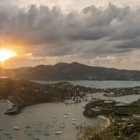
What’s up with the smelly seaweed washing up on the beaches of Florida?

Jun 20, 2023 • 3 min read

Huge clumps of sargassum have been washing up on beaches in Florida and the Caribbean. There’s no need to be (too) alarmed © Felix Leon / AFP via Getty Images
In this series, Lonely Planet’s team of writers and editors answers your travel problems and provides tips and hacks to help you plan a hassle-free trip. We called on Lonely Planet writer Jackie Gutierrez-Jones – a born-and-bred South Florida native and Caribbean expert – to share her thoughts and advice on maximizing your beach vacation when nature has...other plans.
Question: I’ve been hearing some news about smelly seaweed ruining beaches in Florida and the Caribbean. What’s going on, and how could it impact my travel plans?
Jackie Gutierrez-Jones: I’ve also seen the totally not-anxiety-inducing headlines about flesh-eating bacteria proliferating in a gargantuan seaweed blob heading straight to Florida and Caribbean coasts.
So let’s all take a breath, shall we? (But not too deep a breath, since it might smell like rotten eggs – more on that below).
These headlines are referring to a 5000-mile-long mass of sargassum that started blooming to a record-breaking size back in March. It’s been slowly floating along the Atlantic Ocean, threatening to clog up the shores of eastern Florida and the Caribbean this summer.

So, what exactly is sargassum?
It’s really just seaweed. Specifically, a large brown seaweed that bobs around in clumps and patches on the ocean’s surface until it washes up on the shore. Despite all those headlines, sargassum actually plays an important role in the ocean’s ecosystem. It serves as a habitat and food source for various animals, including fish, turtles, birds, crabs and shrimp. It also serves as a nursery for baby mahi mahi and amberjacks.
Sargassum has been a regular feature of Florida beaches for quite some time. (As a kid in Miami, I used to use it to add some thoughtful design touches to my sand castles.)
The problem is that when it gets to shore, it starts to decompose. And when it decomposes, the decaying vegetation produces hydrogen sulfide and ammonia, creating an odor just like…rotten eggs. This can have a potentially serious impact on the health of vulnerable residents and visitors, especially individuals with asthma or other respiratory conditions.
But it’s not just the smell that has people up in arms. Marine biologists from Florida Atlantic University found that the masses of decomposing algae contain high levels of vibrio, a highly salt-tolerant bacteria that can potentially cause serious illness in humans. Ocean pollution has played a role in the spread of vibrio, as the bacteria aggressively seeks out and sticks to plastic floating in the water.

What should I do about my vacation? Is it still safe to head down to Florida or the Caribbean?
While all this news might sound…less than ideal, there’s no need cancel your vacation plans.
In early June, scientists discovered that the Great Atlantic Sargassum Belt (GASB) situation took a highly unusual turn of events: its mass actually decreased by 15%, something that hasn’t occurred in the history of the GASB (going back to 2011). Even better news? The mass is predicted to shrink considerably throughout the summer, with the outlook for July and August looking much less clogged.
Let’s face it: there will probably be above-average amounts of seaweed on the beach this year. Still, Florida and Caribbean beaches are still absolutely stunning and offer tons to do during the summer. Instead of bypassing what’s sure to be an amazing beach vacation, take some smart precautions before you go and prepare to shift plans if necessary. Here are a few tips:
Want to know how much sargassum you can expect at your destination? Check out the webcams of popular beaches.
If you find massive clumps of seaweed on the shore, try to avoid handling them or stepping on them barefoot, as the tiny creatures that live in sargassum may irritate the skin.
If there happens to be a particularly heavy influx of sargassum in your area, you’ll find no shortage of pools, water parks, splash pads and other bodies of water to help you cool off. Make a day trip to a nearby spring or spend an afternoon hiking, canyoning or caving through waterfalls and cenotes.
Explore related stories









